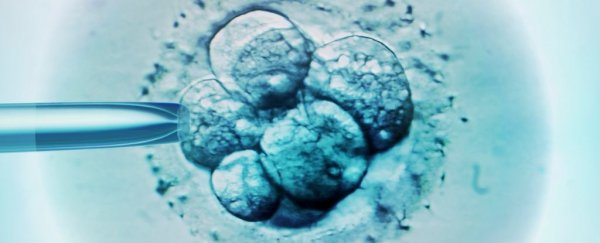Just because a human egg is fertilized does not mean the embryo will survive to birth. In the first few weeks of conception, there's a whole lot that can still go wrong.
When a fertilized egg first begins to divide, it must duplicate its entire genome – that's all the DNA instructions stored in the cell – so that each of the two resulting cells can receive an exact copy. This process must be immaculately repeated each time a cell divides.
But sometimes, it can miss a chromosome or make an extra copy of one.
Scientists still aren't sure why this happens so frequently in early embryos, but they are closing in on the mystery.
"Duplicating the genome is a challenging task for the early embryo," explains cell biologist Dieter Egli from Columbia University.
Human reproduction is far from perfect. In the first few weeks of natural fertilization, a significant yet contentious percentage of embryos fail to implant into the uterus lining.
In vitro fertilization, where the egg is fertilized in the lab, is even more inefficient. Depending on a person's age, between 4 and 50 percent of artificially fertilized eggs actually implant and make it to birth.
In the lab, most fertilized eggs stop developing after a few days, and some 60 percent have an abnormal number of chromosomes.
These chromosomal abnormalities are a major cause of developmental failure in human embryos, but the origins of these early genetic errors are not well understood.
Mistakes in chromosome replication have been thought to occur in the last stages of replication, at the point when the cell is being pulled apart into two identical daughter cells – one chromosome ends up in the wrong cell, leaving two copies in one cell and a missing chromosome in the other cell.
But a new study suggests the problem can start even earlier.
Researchers think that some chromosomal abnormalities may arise from the very first stages of cell division, when the cell is still duplicating its genetic material. In the lab, researchers found human embryos grown in petri dishes already show signs of spontaneous DNA damage even before the cells have properly divided.
Genetic sites that don't get replicated properly can cause a chromosome to break or fragment. More rarely, the replication errors impact the mechanism that pull the chromosomes apart, leading to the wrong number of chromosomes in each resulting daughter cell.
Subsequent cell division could then carry on these errors. And if the mistakes end up in enough cells, it can ultimately lead to an embryo's demise.
Researchers aren't yet sure what initially triggers spontaneous DNA damage, but they think it has something to do with obstacles around the DNA, like interference of molecules that are responsible for turning genes on and off.
A spontaneous break in the double strand, for instance, could slow or stall cell division, resulting in chromosomal abnormalities. The authors, however, can't be sure whether these changes were present in the egg or sperm before fertilization, or if they showed up afterwards.
"This has largely been overlooked in previous studies – because why would the embryo allow the integrity of the genome to be compromised when this is such a critical requirement for normal development?" explains Egli.
If researchers can figure out which signs of DNA damage to look out for in an early embryo, then IVF could one day become a lot more efficient. If the cell doesn't duplicate its DNA properly in the very first stages of cell division, then it is probably not worth implanting.
"Many women undergoing fertility treatment require multiple IVF cycles in order to get pregnant, and some never get pregnant at all," says fertility specialist Jenna Turocy from Columbia University.
"Not only is this enormously expensive, it's emotionally taxing."
The authors hope that one day, they can make assisted reproduction a less heartbreaking process for prospective parents.
The study was published in Cell.
